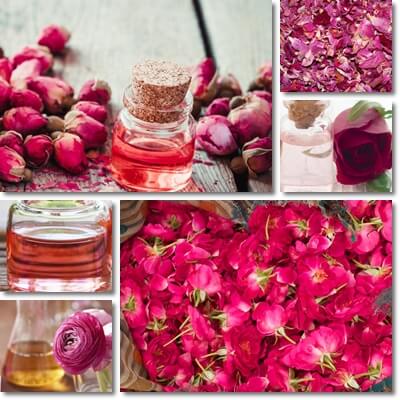Rose essential oil, known simply as rose oil, is a highly fragrant oil made from crushed rose petals. It is predominantly used in the perfume industry, but its uses extend to skin care, the cosmetic industry, aromatherapy and more. Studies show rose essential oil has antimicrobial and antispasmodic properties as well as antioxidant and anti-inflammatory effects. When used topically, it moisturizes skin and combats dryness as well as exerts anti-aging effects. The use of rose essential oil holds benefits for mental health, improves disposition and sleep and helps lower anxiety and reduce stress levels.
What is rose oil?
Rose essential oil is a fragrant oil made from rose petals. As its name suggests, it is an essential oil, meaning it’s made from volatile and aromatic organic compounds that constitute the fragrance essence of the rose flower, versus carrier oils such as olive oil or walnut oil which are made from actual fat, as in fatty acids. Rose oil is not edible, although byproducts of rose oil extraction such as rose water are used as food flavoring.
Internal use of rose essential oil is not safe and the oil is toxic if ingested. Its health-related uses are mainly topical, but rose oil, like all other essential oils, requires dilution prior to application on the skin. The topical use of undiluted, 100% pure rose essential oil will likely result in irritation, redness, itching, red spots on the skin and possibly other side effects, depending on how extensive or frequent the use.

What is rose oil made from?
You can make rose essential oil from any fragrant species of rose, but not all roses are (equally) perfumed and not all yield the same amounts of essential oil. On average, it takes about a thousand rose petals to make a drop of rose essential oil, which explains the preference for both high oil-yielding and more fragrant species. The bulk of rose oil from commercial production is extracted chiefly from two species of rose:
- The Damask rose (scientific name: Rosa damascena), the source of the famous Bulgarian rose oil.
- The Provence rose, cabbage rose or rose the Mai (scientific name: Rosa centifolia).
Types of rose oil
- Rose otto. What is rose oil otto? Also known as rose otto oil, attar of roses or rose attar, rose otto is a type of rose essential oil extracted via steam distillation from rose petals. The recondensed water from the distillation of rose otto is known as rose water. Rose water is a herbal distillate, meaning the essence of a herb or plant extracted through distillation, and it’s a byproduct of rose oil production.
- Rose absolute. What is rose oil absolute? Rose oil absolute is rose essential oil extracted via solvent extraction. Solvents are used to extract the fragrance from the rose petals, and even some of the pigment. The solvents are then removed, the resulting essential oil is filtered and further processed to obtain what is known as rose absolute. The remaining flower matter, a semisolid rose petal mass, is known as concrete.
What is rose water?
Rose water is actually a by-product of the distillation of rose petals for the purpose of producing rose otto essential oil. By definition, rose water is a hydrosol, a colloid dispersed in water. More simply put, it’s an extremely small amount of rose essential oil (otto) suspended in water. Statistically, rose water is only 0.01% and up to 0.05% rose oil, basically an extremely diluted rose oil, hence the reason it’s called rose ‘water’ or, more rarely, rose ‘essential water’ (the key word being ‘water’).
You can also make rose water at home by steeping rose petals from fragrant, edible species such as the Damask rose in water.
What is rose concrete?
Rose concrete is the flower petal mass left over from the solvent extraction of rose absolute oil. It is semi-solid and contains mostly wax, resins and other elements that are soluble in fat, and little fragrant material (volatile aromatic compounds). The concrete is of limited use as it is in the perfume industry, but it used for soap-making and, to a lower extent, in the cosmetics industry.

What does rose essential oil look like?
Rose otto is a light amber to pale yellow color, sometimes almost clear, and liquid. At lower temperatures, tiny crystals form in the oil, increasing its viscosity slightly. By comparison, rose absolute is colorful, with pink-red, reddish, red-orangey, reddish-brown and sometimes even olive-yellowish tones. The difference in color between rose otto and absolute is owed to the fact that rose absolute is extracted with solvents which draws out both the fragrance and pigment compounds from rose petals.
What does rose essential oil smell like?
There is actually a big difference between rose otto vs rose absolute and how they smell. Undiluted rose otto has a deep floral smell with spicy, honey-like notes, but doesn’t smell like fresh roses at all. Rose absolute is rich, warm and spicy, with fresh floral notes and a sweet, flowery scent. The difference in fragrance profile between the two types of rose oil has to do with the extraction methods employed. For example, rose otto is extracted via steam distillation and the high extraction temperatures denature the fragrance compounds in the petals, hence the lack of rosy smell. Rose absolute is extracted via solvents, at lower temperatures, which conserves the properties of the volatile aromatic compounds, hence the more floral smell. But while 100% pure rose oil doesn’t smell much like rose oil, the diluted oil tends to be true to smell.
What are the properties of rose essential oil?
The volatile and aromatic organic compounds in rose oil boast numerous properties and are a source of benefits, such as:
- Source of a pleasant fragrance with benefits for anxiety and stress relief, improving disposition, reducing stress and lowering anxiety levels.
- Antimicrobial, antiviral and anti-fungal properties from the fragrance compounds.
- Mild analgesic, antispasmodic and anti-inflammatory properties.
- Antioxidant and anti-aging properties.
- Makes a good green pesticide and insect-repellent, though it is much too expensive for such uses.
Rose essential oil uses
- Uses in perfumery to make perfumes, eau de parfume, eau de toilette, cologne etc.
- Use in higher-end cosmetics (toners, eye and face creams, day and night face creams, eye and face serums, moisturizers, sunscreens, face masks (detox, purifying, hydrating or rejuvenating masks), body lotions, rejuvenating drops, face capsules).
However, rose water is becoming increasingly popular as an active ingredient in cosmetics. - Use in aromatherapy, as a scented essential oil for massage therapy (diluted with a carrier oil), as a bath oil or for use in diffusers.
- Nutritional supplements, detox capsules.
What is rose oil good for?
- When used in aromatherapy, rose oil reduces stress levels and lowers anxiety.
- Improves disposition and boosts mood, with potential benefits for depression.
- Can help relieve headaches and possibly also migraines, but improper use or overexposure can have the contrary effect.
- Induces relaxation and promotes restful sleep, helping combat insomnia.
- Other benefits for mental health: use of rose oil in aromatherapy bolsters creativity and increases productivity.
- Applied to the skin, diluted rose oil has a light moisturizing and calming action.
- Rose oil for face care calms irritation and exerts an anti-aging effect.
- Rose oil is especially good for sensitive skin and has antioxidant properties.
- Potential benefits for acne thanks to oil’s natural antibacterial inhibiting and bactericidal properties. Studies show rose oil exerts antibacterial action against E. coli, P. aeruginosa, B. subtilis, Staph. aureus and more.
- Rose oil exerts antifungal properties against Candida albicans.
- Potential benefits for nausea and cough.
What are the side effects of Rose Essential Oil?
It’s a known fact that essential oils are not just inedible, but also toxic which is why they are not suitable for internal use (although some are used as food additives in minute amounts). Ingestion of pure rose oil is harmful and causes toxicity, the degree of side effects being dose-dependent.
Similarly, the use of 100% pure rose oil for face care or skin care in general, without prior dilution, negatively impacts skin health.
Side effects may include redness, itching, irritation, discomfort and pain. In rare cases, rose oil can case allergic reactions that can culminate with anaphylactic shock. Overexposure to the scent of rose oil can cause headaches, migraines and even asthma episodes.
